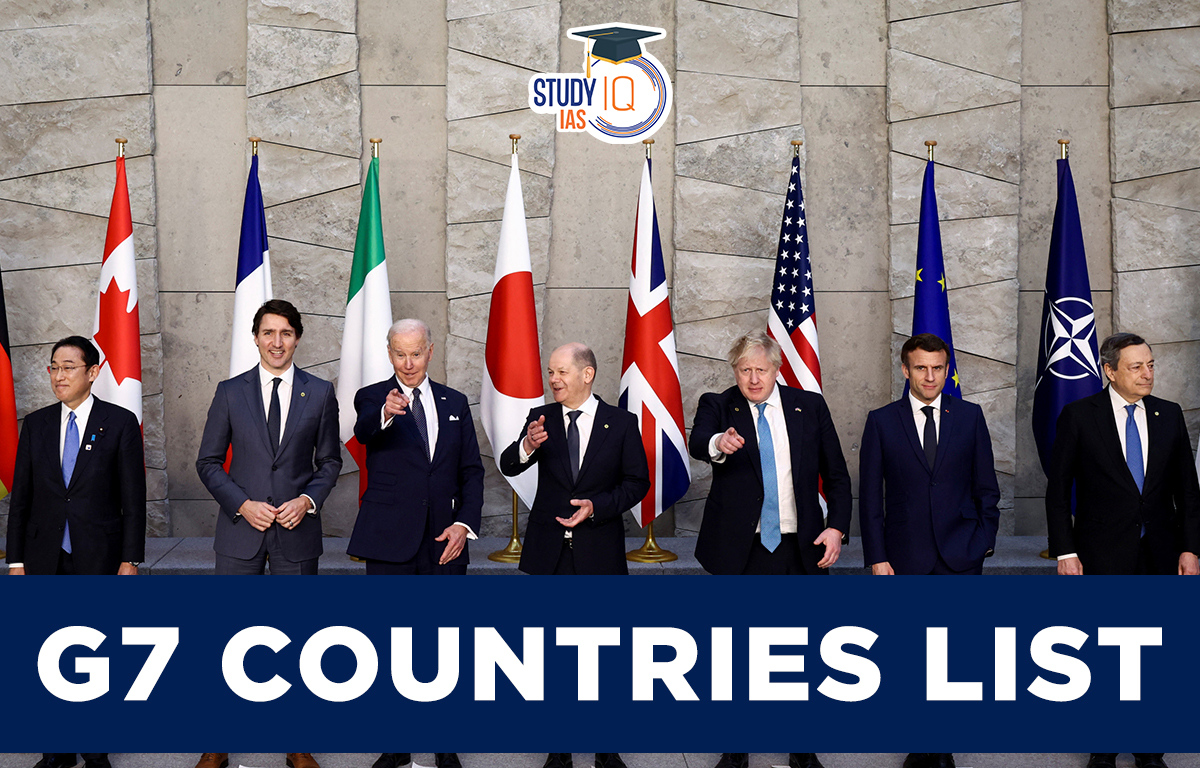Table of Contents
G7 Countries Summit 2025 in Canada
The 51st G7 Summit was held from June 15 to 17, 2025, in Kananaskis, Alberta, Canada. The G7 Countries Summit 2025 will be hosted for the second time in Kananaskis, following its last appearance in 2002. Canada assumed the G7 presidency on January 1, 2025, and will host discussions on several pressing global issues, including economic stability, climate change, and technological innovation.
As the G7 summit marks its 50th anniversary, Canada takes the privilege of chairing the group in 2025. This year provides Canada with an opportunity to demonstrate leadership and foster significant lectures, collaboration and fresh ideas that benefit everyone. The summit will address numerous issues, including world peace, security, robust economies and transformation to digital technology. Here, we highlight the significance of the summit’s main agenda, the attending leaders and the 2025 meeting.
Participating Leaders of G7 Summit 2025
The summit will bring together leaders from the G7 member countries:
| Country Name | Participating Leaders |
| Canada | Prime Minister Mark Carney (Host) |
| France | President Emmanuel Macron |
| Germany | Chancellor Friedrich Merz |
| Italy | Prime Minister Giorgia Meloni |
| Japan | Prime Minister Shigeru Ishiba |
| United Kingdom | Prime Minister Keir Starmer |
| United States | President Donald Trump |
| European Union | Council President António Costa and Commission President Ursula von der Leyen |
Guest Invitees
Additionally, several non-G7 Countries leaders have been invited to participate, including:
- India: Prime Minister Narendra Modi
-
Australia: Prime Minister Anthony Albanese
-
Brazil: President Luiz Inácio Lula da Silva
-
Mexico: President Claudia Sheinbaum (attendance unconfirmed)
-
South Africa: President Cyril Ramaphosa
-
Ukraine: President Volodymyr Zelenskyy
Additional invited international representatives include:
-
NATO Secretary-General Mark Rutte
-
UN Secretary-General António Guterres
-
World Bank President Ajay Banga
Key Agendas of G7 Summit 2025
- Conflict & Peace: Deep concentration on the Israeli-Iranian conflict, with the German chancellor emphasising de-escalation and non-proliferation
- Trade & Tariffs: Tariff tensions remain intense — G7 leaders are calling on the U.S. to turn them back
- Global Priorities:
- Hosted by Host PM Mark Carney, top themes are:
- Peace and security (including Iran, Ukraine, and wildfires)
- Critical minerals, AI, and green energy
- Infrastructure and private-sector collaboration
Notable Developments in G7 Summit 2025
- U.S. President Trump’s Early Exit: Departed summit a day ahead of schedule amid rising Middle East tensions
- G7 Joint Statement: Strong statement reiterating that Iran should never be allowed to get nuclear weapons, combined with a plea for calm in the Middle East.
- U.S.–UK Trade Breakthrough: Trump and UK’s Starmer sign a new trade agreement lowering tariffs on aerospace and autos, although steel levies remain in contention.
G7 Countries: India, Pakistan to De-Escalate Tensions
The Group of Seven (G7) nations, including Canada, France, Germany, Italy, Japan, the United Kingdom, and the United States, and the European Union’s High Representative, have urged an immediate de-escalation of the rising conflict between India and Pakistan.
In a statement released on Friday, May 9, 2025, the G7 Foreign Ministers firmly condemned the atrocious terrorist attack in Pahalgam on April 22nd and called for maximum restraint from both India and Pakistan. They stressed that additional military escalation is a serious threat to regional stability and were deeply concerned about the safety of civilians on both sides.
The G7 Countries called on both nations to a direct dialogue to end hostilities and reaffirmed their pledge to keep the situation under close watch and in favour of a rapid and durable diplomatic solution. This appeal for de-escalation followed reports of both nations conducting retaliatory strikes following India’s Operation Sindoor and Pakistan’s ensuing Operation Bunyan Ul Marsoos.
G7 Countries Group
The Group of Seven (G7) is a political forum made up of Canada, France, Germany, Italy, Japan, the UK, and the US. These countries are some of the largest advanced economies in the world. The G7 countries make up about one-third of the world’s GDP, and all are in the top 10 economies globally. In 2024, their GDP growth and internal equality dropped, but equality started to rise in April. Here are some key points:
- The U.S. has the highest at over $68,000, followed by Germany at $54,000.
- The U.S. is expected to see the largest increase in government debt, while Japan has the highest overall debt
- The 2024 summit took place in Apulia, Italy, discussing health, food security, and AI impacts.
- G7 ministers met in Bologna and Forlì, Italy, from July 9 to 11, 2024.
The G7 collaborates on global issues like climate change and gender equality, with Canada set to host the next summit in 2025. The group started in the 1970s to address economic issues, like the energy crisis and global recession. Over time, it expanded to discuss topics like international security and human rights, focusing on events such as the Iran-Iraq War and the Soviet invasion of Afghanistan.
In the 1990s, the G7 launched a program to help poor countries with debt. In 1999, it helped create the G20, which includes the G7 and other major economies. After the 2007-2008 financial crisis, G7 finance ministers promised to take action to manage the crisis. Today, the G7 continues to oppose Russia’s actions in Ukraine and around the world.
What are G7 Countries?
The Group of Seven (G7) is an informal intergovernmental political and economic forum of seven of the world’s advanced economies: Canada, France, Germany, Italy, Japan, United Kingdom, and United States. The European Union (EU) is also considered a “non-enumerated member”.
The G7 was formed in 1975 by the United States, France, Italy, Japan, the UK, and West Germany as a way for noncommunist powers to address economic concerns. Canada joined the following year. Since the mid-1980s, the G7’s finance ministers and central bank governors have met regularly.
Each year, the G7 leaders meet at a summit to discuss economic and political issues. The summits are organised and hosted by a different member country each time. In addition to the summits, G7 members also hold ministerial meetings to discuss specific issues and global challenges. Government officials called “sherpas” and “sous-sherpas” prepare the groundwork for the summit outcomes, and working groups prepare for ministerial meetings.
G7 Countries Headquarters
The G7 (Group of Seven) does not have any headquarters. It is an informal group of countries that meets every year. The presidency changes each year, with the country in charge hosting the summit and setting the agenda. The 50th G7 summit took place from June 13 to 15, 2024, in Fasano, Apulia, Italy. Prime Minister Giorgia Meloni announced in November 2023 that Fasano would host the G7.
G7 Countries List
The European Union (EU) also participates in the G7 meetings but is not considered a full member. The member countries of the Group of Seven (G7) are:
India’s Role in G7 Countries Group
India’s Economic Significance
India’s economy, with a GDP of $3.57 trillion, is larger than that of four G7 countries: France, Italy, the UK, and Canada. The IMF considers India one of the fastest-growing economies globally. Its young, skilled workforce, low manufacturing costs, and favourable business climate make it a great place for investment.
India’s Strategic Importance in the Indo-Pacific
India has become a key partner for the West in countering China’s influence, especially in the Indian Ocean. It has strong partnerships with the US, UK, France, Germany, and Japan, and is strengthening ties with Italy, making it an important player in the Indo-Pacific region.
India’s Role in the European Energy Crisis
India has secured discounted Russian oil and supplies refined fuels to Europe, helping to address the energy crisis caused by the Ukraine war. As Europe reduces its Russian energy imports, India refines this oil and exports it, easing pressure on European economies.
India’s Potential as a Mediator in the Russia-Ukraine Conflict
India’s good relations with both Russia and the West give it the potential to mediate in the Ukraine conflict. Its neutral stance could help facilitate dialogue and diplomacy to end the war.
Objectives of G7 Countries
- Discussing and coordinating solutions to global issues, such as trade, security, economics, and climate change.
- Discussing topics such as energy policy, international security, and global economic control.
- Serving as a forum for open discussion between leaders, ministers, and policy-makers.
G7 Countries History
The G7, formerly known as the G8, was established in 1975 as an informal gathering place for the heads of the major industrialised nations. Before the 1973 oil crisis, the idea of a forum for the big capitalist industrialised nations first surfaced. The informal meeting of senior financial executives from the United States, United Kingdom, West Germany, Japan, and France became known as the “Group of Five.”
The attendees talked about 1970s economic issues, like the first oil crisis and the end of fixed exchange rates. They agreed on a global economic strategy to tackle the recession. Canada joined the group in 1976, and the first G7 meeting was hosted by the U.S. in Puerto Rico that same year.
Starting in 1981, the European Economic Community (later part of the EU) was invited to every G7 summit by the UK. Russia joined in 1997, making it the G8, symbolising cooperation between East and West after the Soviet Union’s fall in 1991.
G7 Countries Significance
The G7 is considered to have significant international influence and has led or catalysed several major global initiatives. These include:
- Combating the HIV/AIDS pandemic
- Providing financial aid to developing countries
- Addressing climate change through the 2015 Paris Agreement
- Pushing the debate on important global topics, including gender equality and climate change
- Bringing together donors
- Backing disarmament projects
The G7 also plays an important role in global governance, economic coordination, crisis management, and international agenda shaping. However, the G7 has been criticised by observers for its allegedly outdated and limited membership, narrow global representation, and ineffectiveness.


 Iran Nuclear Crisis and India’s Role f...
Iran Nuclear Crisis and India’s Role f...
 H1B Visa Program, Beneficiaries, Eligibi...
H1B Visa Program, Beneficiaries, Eligibi...
 Comparison Between India & France's ...
Comparison Between India & France's ...

























